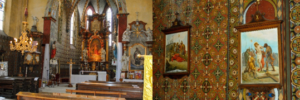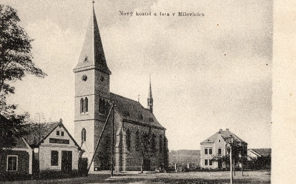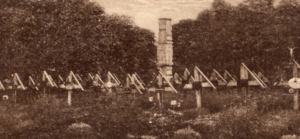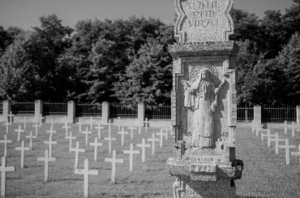Decoration of the Church of St. Catherine of Alexandria and the Military Cemetery
1915 – 1918

During the First World War, prisoners of war created a unique painting of the Church of St. Catherine.
Prisoners of war from the Russian part of Poland, under the leadership of painter Vincenc Klivinský, carried out a unique painting of the Church of St. Catherine of Alexandria in Milovice in 1915–1916. The murals bear the hallmarks of Art Nouveau combined with Eastern folk art. Regular geometric decors alternate with expressive floral motifs. Although the paintings do not contain any elements of Orthodoxy, the unusual colour scheme creates the impression of an Orthodox church. The total cost of the painting was estimated at 1,654 crowns, and the prisoners worked only for food.

The Ministry of Culture of the Czech Republic declared the Church of St. Catherine a cultural monument on July 16th, 2003.
Prisoners of war and Austro-Hungarian soldiers were buried in the civilian cemetery in Milovice until 1915. Due to the large increase in deaths of prisoners, a military cemetery was established near the stone camp. Initially, prisoners were buried in coffins in individual graves, but later they had to be laid undressed in layers on top of each other. The bodies were usually transported to the cemetery after dark so as not to cause a stir among the local population. In later times, three ladder trucks of corpses were taken out of the camp every day. The Milovice parish priest went every morning to sprinkle the prepared pits. After sprinkling, the grave was filled in with chlorine lime and covered with earth. In exceptional cases, Italian music was allowed to play at the funeral. The Russian prisoners had their own choir. After the funeral, the prisoners had to dig a new grave immediately.

After the establishment of Czechoslovakia, the military cemetery was renovated. On October 29, 1922, a monument to deceased Italian prisoners of war was ceremonially consecrated, designed by architect Jaroslav Rössler and sculptor Rudolf Březa.
According to archival documents, 5,276 Italian, 527 Russian and 60 Serbian prisoners of war were buried in the cemetery. Among the Russians were members of other nationalities of the Tsarist Empire – Lithuanians, Estonians, Latvians, Poles and one Finn. 323 Austro-Hungarian soldiers were also buried here, including the commander of the stone camp, Captain Jan Kubeš (1871–1917), and two Czech nurses from the hospital. Some graves are marked according to the faith of the deceased.

During the Soviet occupation, the cemetery was abandoned, a road was widened across the row of graves, a parking area for tanks was concreted, and buildings were built.

The International Military Cemetery in Milovice is now managed by the Italian Republic, which financed its extensive reconstruction. The cemetery, including the newly built memorial hall with an exhibition, is now open to the public.
